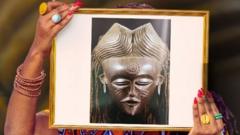In a bold attempt to reclaim African cultural heritage, artifacts from Zambia reveal a sophisticated writing system and underscore women's pivotal contributions in a largely overlooked history.
Ancient African Writing System Challenges Historical Myths

Ancient African Writing System Challenges Historical Myths
An ancient Zambian writing system is reshaping perceptions of African literacy and women's roles in history.
The wooden toolbox inscribed with Sona symbols has ignited discussions on social media, challenging long-held stereotypes that African communities lacked their own literacy. "We've grown up being told that Africans didn't know how to read and write," explains Samba Yonga, co-founder of the Women's History Museum of Zambia. This initiative aims to revive a cultural legacy that colonialism has nearly erased, showcasing artifacts that highlight the significant roles women played in ancient societies.
Among the treasures shared online is a beautifully adorned leather cloak, dormant for over a century, symbolizing a rich heritage worthy of recognition. Yonga emphasizes the need to connect with this cultural identity, saying, "We had our own language of love, of beauty [...] and ways of taking care of our health and environment." The Frame project, initiated in 2019, features 50 items reflecting women's understanding of nature, emphasizing that the colonial narrative has often distorted African histories.
Zambian artifacts, primarily collected during the colonial era, have been stored in global museums, including Sweden, where Yonga unearthed a trove of nearly 650 items. These findings, surprisingly untouched by researchers, reveal lost knowledge about textiles like the leather cloak, crafted for both utility and aesthetics by the Batwa men and women in the Benqueulu area of northeast Zambia. Unfortunately, much of this rich history remains unremembered locally, following the destruction of traditional knowledge.
The intricate Sona writing system is another focal point, characterized by geometric patterns used for communication, symbolism, and instructions related to community life. Women were the original custodians of this knowledge, and the excitement around Sona highlights a broader resurgence of interest in the origins and depth of African culture.
A poignant example of African women's power comes from a grinding stone that was used not merely in the kitchen but as a gravestone for respect and legacy. The Women's History Museum of Zambia hopes to bridge the gaps in historical narratives, creating a treasure trove of knowledge that reshapes how individuals relate to their past.
The enduring impact of these cultural artifacts on self-identity and empowerment is profound, as Yonga notes, "Having a sense of my community [...] has changed the way I interact in the world." As this online campaign unfolds, it recognizes the historical significance of women in Africa, promising to transform perceptions and spark a renewed appreciation for a vibrant heritage.
Penny Dale, a London-based journalist, continues to explore these compelling stories and the broader implications for cultural recognition.
Among the treasures shared online is a beautifully adorned leather cloak, dormant for over a century, symbolizing a rich heritage worthy of recognition. Yonga emphasizes the need to connect with this cultural identity, saying, "We had our own language of love, of beauty [...] and ways of taking care of our health and environment." The Frame project, initiated in 2019, features 50 items reflecting women's understanding of nature, emphasizing that the colonial narrative has often distorted African histories.
Zambian artifacts, primarily collected during the colonial era, have been stored in global museums, including Sweden, where Yonga unearthed a trove of nearly 650 items. These findings, surprisingly untouched by researchers, reveal lost knowledge about textiles like the leather cloak, crafted for both utility and aesthetics by the Batwa men and women in the Benqueulu area of northeast Zambia. Unfortunately, much of this rich history remains unremembered locally, following the destruction of traditional knowledge.
The intricate Sona writing system is another focal point, characterized by geometric patterns used for communication, symbolism, and instructions related to community life. Women were the original custodians of this knowledge, and the excitement around Sona highlights a broader resurgence of interest in the origins and depth of African culture.
A poignant example of African women's power comes from a grinding stone that was used not merely in the kitchen but as a gravestone for respect and legacy. The Women's History Museum of Zambia hopes to bridge the gaps in historical narratives, creating a treasure trove of knowledge that reshapes how individuals relate to their past.
The enduring impact of these cultural artifacts on self-identity and empowerment is profound, as Yonga notes, "Having a sense of my community [...] has changed the way I interact in the world." As this online campaign unfolds, it recognizes the historical significance of women in Africa, promising to transform perceptions and spark a renewed appreciation for a vibrant heritage.
Penny Dale, a London-based journalist, continues to explore these compelling stories and the broader implications for cultural recognition.




















